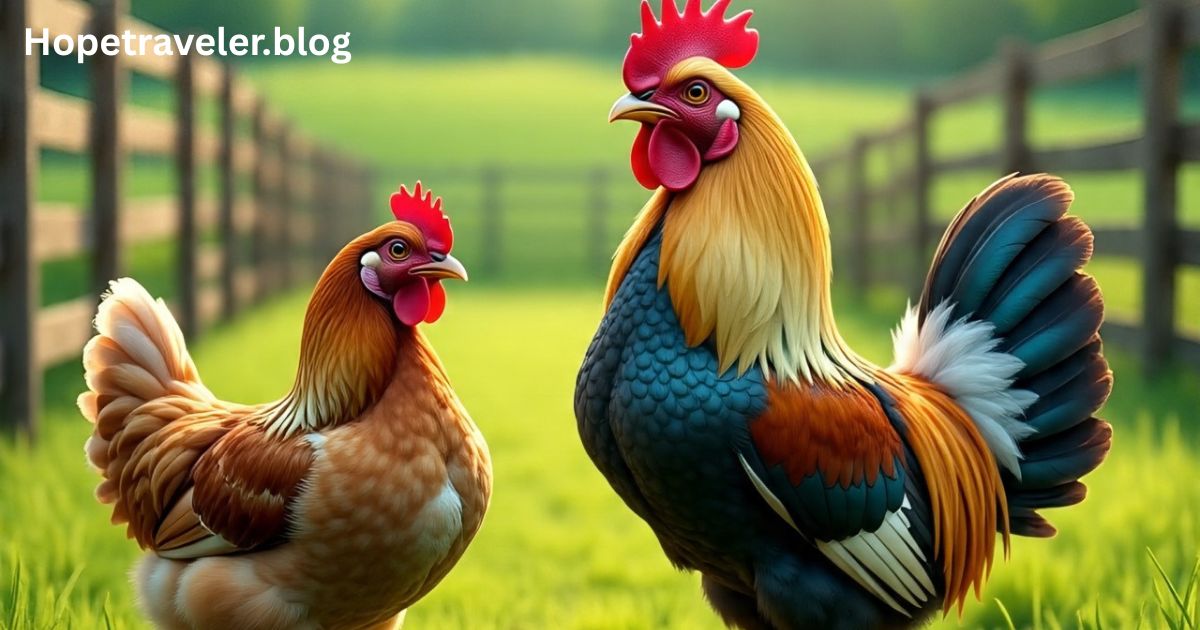The difference between a hen and a rooster is one of the most fundamental concepts in poultry farming, bird biology, and even common rural life. While both belong to the same species—the domestic chicken (Gallus gallus domesticus)—they have significant physical, behavioral, and reproductive differences that set them apart. Understanding these differences is essential not only for farmers but also for anyone interested in animal husbandry, pet ownership, or poultry breeding.
In this article, we will explore the major differences between a hen and a rooster, including their anatomy, behavior, role in reproduction, and cultural significance. We’ll also look at why these differences matter in farming and everyday life.
What is a Hen?
A hen is an adult female chicken, primarily known for laying eggs. Hens are generally calmer, less aggressive, and smaller compared to roosters. They are vital in poultry production, as they are the ones responsible for producing the eggs we consume. In terms of reproduction, hens can lay eggs without a rooster present, but these eggs will be unfertilized and cannot develop into chicks.
Hens are typically raised for:
- Egg production (layers)
- Meat production (broilers)
- Breeding purposes in combination with roosters
For a detailed definition, see the Wikipedia page on hens.
What is a Rooster?
A rooster is an adult male chicken. Roosters are easily recognized by their larger size, vibrant feathers, and iconic crowing sound, which usually occurs early in the morning but can happen throughout the day. They play a crucial role in fertilizing eggs, which is essential for breeding new chicks.
Key traits of roosters:
- More colorful and ornamental plumage than hens
- Prominent combs and wattles
- Spurs on legs for fighting and defense
- Dominant and territorial behavior
Primary Differences Between a Hen and Rooster
Let’s break down the differences between a hen and a rooster into several categories:
1. Physical Appearance
| Feature | Hen | Rooster |
|---|---|---|
| Size | Smaller, lighter | Larger, heavier |
| Comb and Wattles | Smaller, less prominent | Larger, more pronounced |
| Feathers | Duller, uniform colors | Bright, iridescent colors |
| Tail Feathers | Short and less curved | Long, flowing, and arched |
| Spurs | Usually absent | Present and sharp |
Roosters are more visually striking, often with a mix of shimmering green, orange, and black feathers. This ornamental look is due to sexual dimorphism, where males of a species have more elaborate features than females to attract mates.
2. Behavior
| Aspect | Hen | Rooster |
|---|---|---|
| Aggression | Passive, gentle | Aggressive, territorial |
| Crowing | Does not crow | Famous for loud crowing (“cock-a-doodle-doo”) |
| Protective Nature | Protects chicks after hatching | Guards flock against predators |
Roosters are dominant and territorial, often fighting other males to establish hierarchy within the flock. Hens, on the other hand, are more nurturing, especially when brooding and raising chicks.
3. Role in Reproduction
- Hen: Lays eggs whether or not a rooster is present. Without fertilization, eggs will never hatch into chicks.
- Rooster: Fertilizes the eggs by mating with hens. A single rooster can mate with multiple hens.
4. Egg Production
Hens begin laying eggs at about 5–6 months old, producing anywhere between 250 to 300 eggs annually in commercial breeds. Roosters, of course, do not lay eggs. Their primary biological role is to fertilize the eggs laid by hens.
5. Sound Differences
- Hens make clucking sounds and sometimes soft coos.
- Roosters crow loudly, which can be disruptive in urban settings. This crowing is a natural behavior used to establish dominance and alert the flock.
6. Lifespan
Both hens and roosters have similar lifespans, typically ranging from 5 to 8 years in good conditions, though this can be shorter in commercial farming environments.
Cultural and Symbolic Roles
Hens and roosters hold significant cultural symbolism worldwide. The rooster is often associated with courage, vigilance, and masculinity, thanks to its crowing at dawn and aggressive demeanor. Many cultures, such as the French, use the rooster as a national symbol.
Hens symbolize motherhood, fertility, and nourishment, given their egg-laying capacity and maternal instincts. In folklore and rural traditions, hens and roosters are central figures representing prosperity and daily life.
Why Are Roosters Often Banned in Urban Areas?
Many cities restrict or ban roosters in residential areas because of their loud crowing, which can disturb neighbors. Hens, however, are usually allowed because they are quieter and provide fresh eggs for households.
Importance in Poultry Farming
Understanding the difference between a hen and a rooster is crucial for poultry farming:
- Egg Production: Farms focused on eggs prefer hens only.
- Breeding: Farms producing chicks require both hens and roosters.
- Meat Production: Both are raised, but broilers are typically processed before adulthood, reducing behavioral issues.
Key Biological Differences at a Glance
- Sexual Organs: Roosters have testes, while hens have ovaries and oviducts for egg production.
- Hormonal Influence: Testosterone in roosters contributes to aggression and larger body size.
- Molting and Feathers: Roosters often grow more elaborate tail feathers and hackle feathers.
How to Identify a Young Hen or Rooster (Chick Stage)
Identifying gender in chicks can be tricky, but here are some clues:
- Rooster chicks often develop larger combs earlier.
- They may stand taller and show more dominant behavior.
- Feather growth patterns differ slightly.
This process, called sexing, is important for farmers who need specific ratios of hens and roosters.
Scientific Classification
Both hens and roosters belong to the same species: Gallus gallus domesticus, under the family Phasianidae. The wild ancestor is the red junglefowl, native to Southeast Asia. Learn more about this species from Wikipedia’s chicken article.
Fun Facts About Hens and Roosters
- A rooster’s crow can be as loud as 90 decibels, similar to a barking dog.
- Hens have a strong social hierarchy known as the pecking order.
- Roosters perform a courtship dance called tidbitting to attract hens.
- Hens can store sperm from roosters for up to two weeks to fertilize eggs later.
Which One Should You Keep at Home?
For backyard farming:
- If you want eggs only, keep hens (no rooster needed).
- If you plan to breed chicks, you’ll need at least one rooster for every 8–10 hens.
- Check local regulations, as roosters may not be allowed in urban settings.
Conclusion
The difference between a hen and a rooster goes beyond simple gender distinctions. It encompasses their physical appearance, behavior, reproductive roles, and cultural significance. While hens are valued for egg production and nurturing qualities, roosters are admired for their strength, vibrancy, and role in flock protection and breeding.
For farmers, hobbyists, and even curious learners, understanding these differences helps in better poultry management, ensuring the well-being of the flock and meeting production goals.


